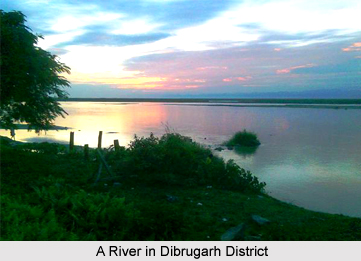 Climate of Dibrugarh District is basically sub-tropical monsoon because of its unique physiographic elements. This district experiences mild winter, warm and humid summer. Rainfall decreases from south to north and east to west in the region. The average annual rainfall of Dibrugarh city in the north is 276 cm with a total number of 193 rainy days, while at Naharkatia in the south the average rainfall is 163 cm with 147 rainy days. The temperature normally decreases from south to north. The average annual temperature in Dibrugarh and Naharkatia is 23.9 degree Celsius and 24.3 degree Celsius respectively.
Climate of Dibrugarh District is basically sub-tropical monsoon because of its unique physiographic elements. This district experiences mild winter, warm and humid summer. Rainfall decreases from south to north and east to west in the region. The average annual rainfall of Dibrugarh city in the north is 276 cm with a total number of 193 rainy days, while at Naharkatia in the south the average rainfall is 163 cm with 147 rainy days. The temperature normally decreases from south to north. The average annual temperature in Dibrugarh and Naharkatia is 23.9 degree Celsius and 24.3 degree Celsius respectively.
Being situated on the bank of Brahmaputra River, the climate of Dibrugarh city is mild with low temperature and high rainfall as compared to Chabua in the east and Moran Town in the west. The standard annual temperature in Chabua and Moran is 28 degree Celsius and 32 degree Celsius respectively. Rainfall records show a declining drift towards east and west of the Dibrugarh city. The annual amount of rainfall in Chabua and Moran is 250 cm and 171 cm and 171 cm respectively.
Based on the climatic distinctiveness such as distribution of temperature, rainfall, rainy days, humidity, presence of fog and thunderstorms, the climate of Dibrugarh District may be classified into four seasons and these are winter, pre-monsoon, monsoon and retreating monsoon. The winter mainly covers the months of December, January and February. In this season, fair weather prevails occasionally associated with fogs and haze. December and January are the dry months and January is the coldest. The minimum temperature varies between 8 degree Celsius and 10 degree Celsius and the maximum between 27 degree Celsius and 29 degree Celsius. The average rainfall in the winter season is 20 cm.
Moreover, the months of March, April and May constitute the pre-monsoon season. From March, the land surface gets steadily heated and the temperature starts rising. Strong convection develops due to the narrow depressions formed especially in the afternoon. Maximum temperature ranges between 28 degree Celsius and 32 degree Celsius. This season is, in fact, a transitional phase between the dry cool winter and the warm moist monsoon. With the onset of monsoon in early June, heavy rainfall occurs in Dibrugarh District. Widespread low clouds and high humidity maintain uniform temperature over the region.
The maximum temperature varies between 33 degree Celsius and 37 degree Celsius. The average annual rainfall during the period is 300 cm. The occurrence of thunderstorms is the most obvious characteristic in this weather. The monsoon season is considered as the season of dominant agricultural operation in the area.
The monsoon withdraws from the area either in the last week of September or in the first week of October. The cool northeasterly winds originating over the superior mountains of the Arunachal Himalayas bring the temperature down. Rainfall decreases abruptly. Sunny days prevail until the end of November. Thus, warm and humid weather prevails in Dibrugarh District and it has a profound influence on the economy and life of the people of the area. This climate of the district is most suitable for the cultivation of a variety of grain and horticultural crops.






